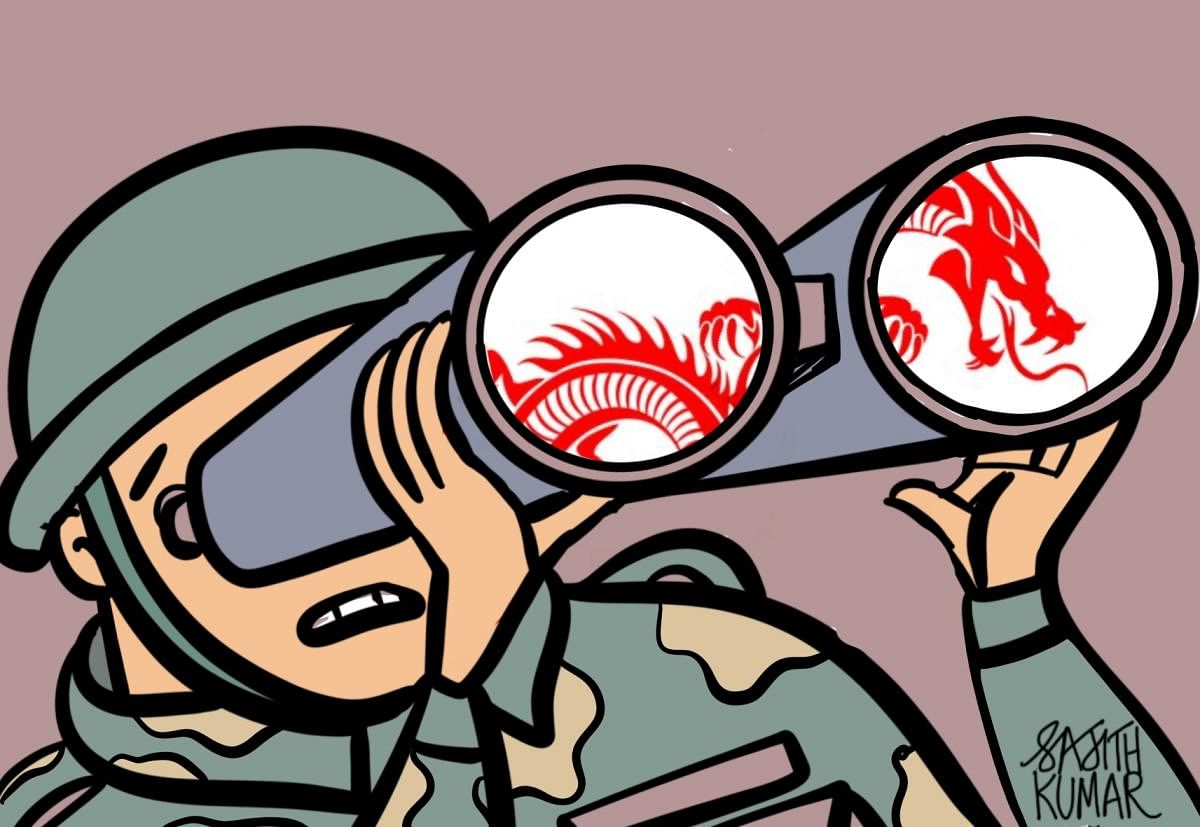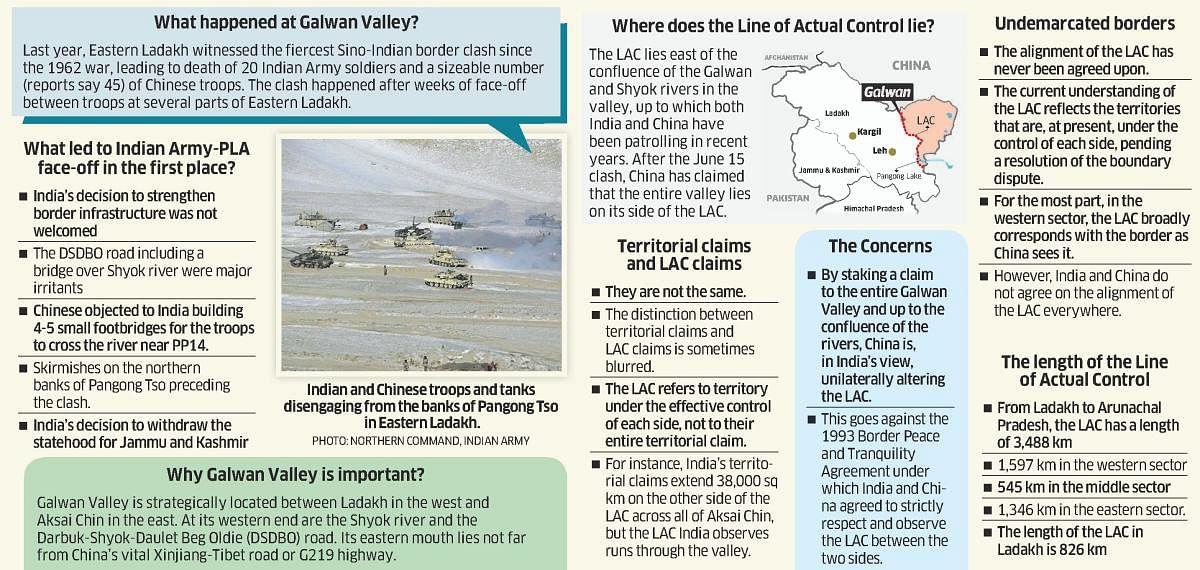

On June 15 afternoon last year when Col B Santosh Babu led his men to Patrolling Point 14 in the Galwan Valley, his aim was to check whether soldiers of the People’s Liberation Army of China were complying with what their superiors had agreed upon at a Corps Commander’s meeting 10 days’ ago. As per the agreement reached between the two sides, the PLA troops were to dismantle a make-shift bunker set up on the Indian soil near the Galwan river and return to their post 1.5 km away to the east. Babu’s job was to ensure compliance.
As dusk approached, the PLA troops suddenly turned around and attacked the Indian soldiers. Col Babu was in the front and was hurt seriously. Two other men - Havildar K Palni and Sepoy Kundan Ojha - were also killed in the attack while several others were held captive and released a day later.
With the arrival of reinforcement from both sides, the clash intensified. The troops used iron studded rods, sticks and clubs for the bloody hand-to-hand combat as the brawl continued for several hours. Men also fell into the Galwan river where they died due to hypothermia.
A day later, Indian Army confirmed the fiercest Sino-Indian encounter on the Line of Actual Control since the 1962 war. In a statement, the force said, “17 Indian troops who were critically injured in the line of duty at the stand-off location and exposed to sub-zero temperatures in the high altitude terrain, have succumbed to their injuries, taking the total that were killed in action to 20.”
Since then, much water has flown in Shyok, Galwan and Chip-Chap rivers but the ground situation has not changed much in most of the friction points in Eastern Ladakh. The LAC still remains tense though the two sides managed to deescalate on the northern and southern banks of the Pangong Tso after the 10th round of Corps Commanders conference. However, the 11th round that happened in April did not yield any breakthrough on other flash points like Hot Spring, Gogra post, Depsang plains and Demchok even as Army sources observed that a resolution on the Depsang and Demchok was unlikely at this point.
“The Galwan episode was a planned and deliberate ambush. The response and retaliation by Col Santosh Babu and his men inflicted unexpected costs on the PLA. The PLA would have planned many such Galwans but the retaliation by Col Babu has ensured peace along the LAC, albeit a fragile one,” Lt Gen Vinod Bhatia (retd), former director general of military operations and director of the Centre for Joint Warfare Studies, told DH.
Army Chief Gen M M Naravane too admitted it was a fragile peace that was being seen in Ladakh. “Inadvertent incidents can happen due to over-enthusiasm of local commanders, which have to be guarded against. We, of course, can’t be complacent. We have to keep a strict watch. We are doing it. Negotiations are being conducted for resolution of other friction points in a firm but non-escalatory manner,” he said in a recent interview.
Since April, there is barely any progress on the next round of talks between the two neighbours on restoring status quo at least in Hot Spring and Gogra post areas, which could be low hanging fruits in such a long-drawn negotiation process. “It is a game of patience with the Chinese. Continue with the parleys at all levels, demonstrate your strength and resolve and continue with a strategy of ‘No blinking No Brinkmanship,” said Lt Gen Bhatia.
Removing Depsang thorns, however, would take a long time as it is a legacy issue and predates last year’s crisis. Depsang provides an alternate and a shorter access to the Karakoram pass. It is also close to India’s highest airfield at Daulat Beg Oldie (DBO). The airfield sits at the base of the Karakoram pass, which separates Xinjiang Autonomous Region from Ladakh. A foothold in the area has a potential to cause disturbance on the traffic movement on the 255 km DSDBO road that runs almost parallel to the LAC connecting Leh with DBO.
To the west of DBO is the region where China abuts Pakistan in the Gilgit-Baltistan area. This is the region where China is constructing the China-Pakistan Economic Corridor in Pakistan-Occupied Kashmir to which India has objected. The area was a part of the 5,189 sq km that Pakistan illegally ceded to China in 1963 under a Sino-Pakistan Boundary Agreement, contested by India. The DSDBO road is crucial to the defence of the entire area as the other approach road to DBO remains under snow for the better part of the year.
The crisis has its genesis in a letter that Chinese premier Zhou Enlai wrote to Indian Prime Minister Jawaharlal Nehru on November 7, 1959 making certain territorial claims. Though India never recognises such a claim, China reiterates it every now and then. “Depsang is the place where the areas of differing perceptions are maximum. It predates the present situation. Since it is a large area, patrols from both sides face off. This is the prevailing situation. The situation is not volatile there and has to be resolved at some point,” Lt Gen Y K Joshi, the Northern Army Commander, had stated earlier this year.
Down below at the boomerang-shaped turquoise blue Pangong Tso – a traditional face off spot - there is truce at the moment. A section of the veterans is of the opinion that India have paid too much – vacating the dominating heights on the Kailash range on the southern banks of the lake overlooking the Moldo garrison - to attain peace. Gen Naravane, however, contested, arguing that the Army had analysed all situations before deciding on such a step.
Strategic value
“The strategic value of any quid pro quo option is not infinite. It is limited in time and space. This helped in the disengagement of the most sensitive standoff at Pangong Tso. We still have many more options, if required,” the former DGMO said when asked if it was a wise decision to vacate the heights on the Kailash range. Both sides currently have 50,000-60,000 troops in the sensitive area and kept adequate reserves at intermediate depth so that the troops can be quickly brought in to tackle any contingency.
Over the past year, PLA has reportedly constructed permanent structures in locations they occupied last year in Eastern Ladakh and ramped up logistics. Both sides also brought in new weapons in the depth areas. With the mutual trust level falling to the nadir, it may now take a long time to achieve any breakthrough in the negotiations. “The trust levels are bound to be low when a major standoff takes place between two countries leading to casualties on both sides. However, it is always our endeavour that this trust deficit should not hinder the negotiation process,” Gen Naravane said.
“We are very clear that no de-escalation can take place before disengagement at all friction points. India and China have signed a number of border agreements which have been unilaterally breached by the PLA. Though we want peace and tranquility at the LAC and are open to initiating confidence-building measures, we remain prepared for all contingencies.”
There is no confrontation along the LAC in other areas particularly in Sikkim and Arunachal Pradesh. However, it doesn’t mean such a possibility does not exist. Galwan was not among the 23 known flash-points or “areas of differing perception” but still became a confrontation zone.
“Escalation in other areas is a possibility. However, thankfully such a thing has not taken place, as we have the requisite combat power and capability to respond. We must keep the dialogue process going at all levels - diplomatic, military and political. But at the same time prepare for a long haul along the LAC,” noted Lt Gen Bhatia.
